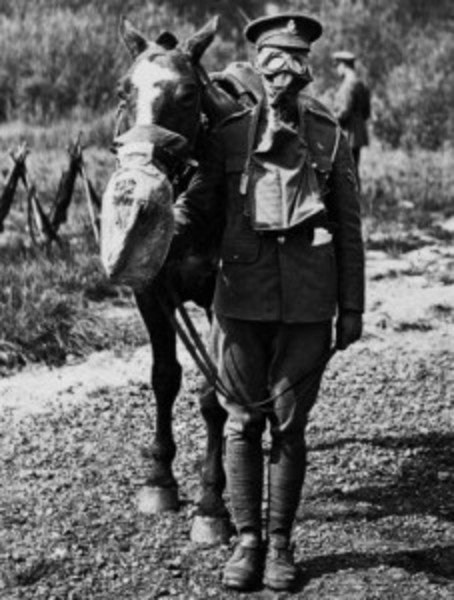Soldier and horse wearing gas masks in World War I. Michigan State tested air quality in racetrack stables for two years. (Wellcome Medical Library image)

Thistledown Race Track near Cleveland, Ohio can come up for air now. The stable area there has been a test site for the past two years, as researchers from Michigan State University, with funding from the Grayson Jockey Club Research Foundation, took measurements to determine relative air quality inside the barns.
Melissa May, currently a PhD student in MSU’s College of Veterinary Medicine’s Comparative Medicine and Integrative Biology program, wanted to study the exposure of racehorses to airborne particulate matter and its relationship to mucus production in the airways.
The researchers used the same technology for monitoring stable particulates that is used in human workplaces. In the first year, the team measured the ambient air quality. As expected, the research showed the air quality varied month-to-month and between stables — open air fared better than closed — and that stables’ air was more particle-clogged in the morning during cleaning. More interestingly, certain stalls within stables consistently had the highest particle concentrations.
After those observations, Dr. Edward Robinson, MSU CVM’S Matilda Wilson Professor of Large Animal Clinical Sciences, says, they were able to determine that there is a relationship between air particles and presence of mucus in horses’ air passages. “It was a significant relationship,” he says. But surprisingly, “the most important factor determining the presence of mucus is actually the trainer. When we say trainer, we mean everything else in the stable we haven’t measured.”
Some stables are very busy; others are more tranquil. Some have more horses brought in and out; some have lights on all night. “So we’ve noticed a lot of different management factors that may account for the severity of mucus and inflammation,” Robinson says.
In 2007, the team measured the personal exposure of horses to dust — that which accumulates in their nostrils. Horses wore samplers, much as humans do for such testing, and tubes were run up the horses’ necks, down their faces and near their nostrils. They measured 60 case horses and 60 control horses. Those data are now being analyzed.
But May says the study has netted some benefit already. “There are a lot of very easy and inexpensive things we can do to improve the horses’ environment to reduce exposure to particulates,” she says. “In the end, we will be able to give some valuable recommendations to the race track as to how to control particulates in stables.”








